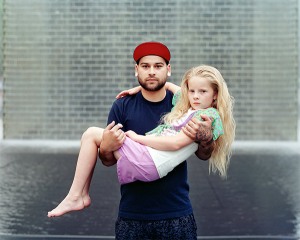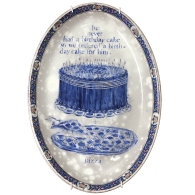Advent … An Old Fresh Look
December 10, 2018
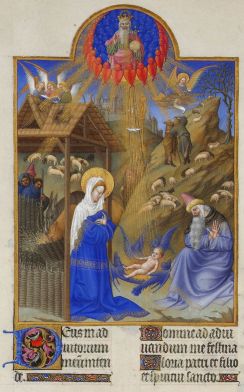
Limbourg Brothers, Nativity (folio 44v), Tres Riches Heures, 1414-16 (Musee Conde)
This charming little image is a single page from a manuscript called the Tres Riches Heures(or, in English, the “Very Rich Hours”). As the title suggests, the manuscript is a Book of Hours, which was a type of devotional book that was very popular in the Medieval period. Books of Hours typically contained a smattering of prayers, hymns, and biblical passages along with images that could enhance one’s understanding of the text or encourage spiritual reflection.
This particular Book of Hours was created for the Duke of Berry in the early 15th century by the Limbourg Brothers, and it was—as the name suggests—“very richly” decorated with ornate letters and images. Each page is 8 ½ by 10 inches. All the text was hand lettered. All the pictures and decorations were painted with very expensive pigments using very fine brushes.
The illumination of the Nativity appears with a group of prayers associated with the Virgin. Here we find lots of familiar imagery. Mary and Joseph and the Baby Jesus, of course. A stable with the standard ox and ass. An angel visiting shepherds with their rather large flock by night. Even an angel choir.
But there are some unusual elements as well—the most obvious of which are the curious blue angels swirling around baby Jesus.
 While somewhat strange to us, this imagery would have been familiar to original viewers. In the previous century, a mystic named Bridget of Sweden had a vision that became famous around Europe after her death in the 1370s. Consequently, it inspired a shift in the way the Nativity was represented. In her vision, she saw Mary deep in prayer when suddenly the infant Jesus appeared before her on the ground, naked and glowing. When Mary realized she had just given birth, she bowed her head and crossed her arms in adoration, saying, “Welcome, my God, my Lord, and my Son.” Then Joseph, too, saw the infant and adored him on bended knee.
While somewhat strange to us, this imagery would have been familiar to original viewers. In the previous century, a mystic named Bridget of Sweden had a vision that became famous around Europe after her death in the 1370s. Consequently, it inspired a shift in the way the Nativity was represented. In her vision, she saw Mary deep in prayer when suddenly the infant Jesus appeared before her on the ground, naked and glowing. When Mary realized she had just given birth, she bowed her head and crossed her arms in adoration, saying, “Welcome, my God, my Lord, and my Son.” Then Joseph, too, saw the infant and adored him on bended knee.
Following Bridget’s vision, the Limbourg brothers show the moment immediately after Jesus’s birth. He has just appeared outsidethe womb as miraculously as he appeared insidethe womb nine months before. Mary and Joseph’s first reaction, as it should be when gazing at the glowing Son of God, is adoration. We are left to imagine that Mary’s next move is to pick up that poor baby and swaddle him tight.
The Brothers add other bits to emphasize that this is not a typical birth nor a typical baby. The blue angels, for instance, cradle the baby in a nest of golden beams of light, acting as heavenly midwives for this miracle. Unlikein Bridget’s vision, they seem to be suspending him above the bare ground. This special babe is also bathed in light streaming down from a heavenly sphere above, where God the Father stands surrounded by blue and red angels, or more specifically cherubim and sheraphim. The orb in his left hand signifies his authority, as does the crown, but with his right hand, he makes the gesture of blessing, presumably directed toward the people below on whom the most precious blessing is being bestowed presently.
 What is more unusual for a nativity is the stream of light that flows out of God’s mouth. It descends all the way to the baby below, clearly conveying that this baby is the Word of God, spoken and now made flesh. And, just in case you’ve missed theseindications of the baby’s divinity, the artist throws in one more detail for good measure—a bright white dove symbolizing the Holy Spirit. Its presence makes clear that this very human baby is also the third member of the Triune God.
What is more unusual for a nativity is the stream of light that flows out of God’s mouth. It descends all the way to the baby below, clearly conveying that this baby is the Word of God, spoken and now made flesh. And, just in case you’ve missed theseindications of the baby’s divinity, the artist throws in one more detail for good measure—a bright white dove symbolizing the Holy Spirit. Its presence makes clear that this very human baby is also the third member of the Triune God.
While the Limbourg Brothers clearly stress Christ’s divinity, there are other theological assertions to be found here—some of which relate to the significance of the birth of Christ for human history. Take the dilapidated stable. It is easy to surmise that the shabby condition of the stable symbolizes the poor and humble conditions into which Christ was born, but historically it carried a different meaning. The old stable represents the Old Testament—or the old order of things—which at the birth of Christ is now passing away. Here the light emanating from heaven at this momentous occasion seems to actually break through the roof—the advent of the new actually causing the ruination of the old.

The Jewish law is not the only tradition being supplanted; pagan gods are also made obsolete. If you look closely at the hillside in the background, you can make out what appears to be a large golden statue of a pagan god elevated on a column. Once prominent in the landscape, it is now obscured by the dense beams of light that signal the coming of the true God. The old has gone the new has come.
All this gives me pause.
I have only anecdotal evidence by way of the Christmas cards that find their way to my house, but it seems that we tend to gravitate toward more cozy images of the Nativity—ones in which Mary is the doting mother and the baby is snug in her arms or nestled in a manger.
But the Limbourgs’ image doesn’t let me get absorbed in the preciousness of the moment. Instead, it prompts me to contemplate the theological meaningof this event and my own response. If I consider deeply the divine identity of this baby, my response would be more like Bridget’s Mary: to bow and adore him, but not the kind of adoration of tender and affectionate parents so in love with their newborn baby, but the adoration of a humble subject toward a righteous king.
 On either side of Mary and Jesus, we are given suggestions for other appropriate responses to this event. On the left, three shepherds push up against the fence. I especially appreciate the two guys in the back who seem to jostle to get a better view, similar perhaps to adults at our own Christmas pageants who shift to see what’s going on up front. As sweet at those pageants are, I wonder if I work as hard to see and understand the historic event. Can I imagine myself in these shepherds’ position, trying to wrap my mind around the wonders of what’s happening here?
On either side of Mary and Jesus, we are given suggestions for other appropriate responses to this event. On the left, three shepherds push up against the fence. I especially appreciate the two guys in the back who seem to jostle to get a better view, similar perhaps to adults at our own Christmas pageants who shift to see what’s going on up front. As sweet at those pageants are, I wonder if I work as hard to see and understand the historic event. Can I imagine myself in these shepherds’ position, trying to wrap my mind around the wonders of what’s happening here?
Which brings us to Joseph. Admittedly, I’ve always had a soft-spot for Joseph. Here, the Limbourg Brothers give him a particularly old and somewhat regal appearance. He looks down at this baby that has suddenly appeared surrounded by bright blue angels, and he also bows in adoration. But he also registers his surprise, if in a most understated manner. While certainly extra-biblical, I appreciate the artists’ effort to remind us just how surprisingall of this is. This story has become so familiar that we can easily take it for granted: God comes into the world as a baby? Sure, why not. But the incarnation is surprising. The God in baby-form is surprising. Joseph ought to have been surprised when that baby showed up. So should we.
Like most Medieval artists, the Limbourg brothers don’t let us simply dwell on Advent. This image also foreshadows things to come. First, at the very bottom, the ground seems to drop off rather close to where the Holy Family are situated. Artists incorporated such holes or pits to subtly point to Christ’s eventual suffering and death. Likewise, the bare and twisted tree on the hill calls to mind the cross on Golgotha. These references are not surprising. Even in Bridget’s vision, Mary has a premonition of Jesus’s eventual suffering and bursts into tears. She hasn’t yet come to that in this image, but the Limbourg Brothers set the stage.
This Advent season, I hope I will be prompted to look with fresh eyes, to seek new and deeper understanding, and to bow down with deep adoration.
Seeing Grace
May 13, 2018

This detail comes from a painting by Frederick Hardy called Try This Pair. It’s a quirky genre painting of a door-to-door eye-glasses salesman. While he offers different pairs to an older gentleman who is testing them with a newspaper, this boy has clearly snitched a pair off the table to try on himself. His expression suggests that he has just discovered what the world really looks like.
I distinctly remember the first time I got glasses as a teenager. Exiting the shore, I looked out over the parking lot and then to the mountains beyond, and I couldn’t believe how clear everything was. Edges were sharp! Trees had leaves! My prescription was slight, but oh what a difference it made.
This post from way back in January came to mind because I’ve been going to an adult forum series on how we experience God and are thus transformed through our senses. I firmly believe that our five senses are avenues for God’s grace. The smell of dinner when I walk through the front door is God’s grace. The sound of birds in the springtime is God’s grace. The sight of blossoming trees and blooming flowers is God’s grace. These things are not earned or deserved, they are gracious gifts.
The forum on Sundays has reminded me of how important it is to pay attention. Be present. Stop and breathe in the smell … listen to the sound … look at what I’m seeing. Really look.
The expression on the boy’s face says it all.
My eyes have gotten worse lately. I should go to the optometrist.
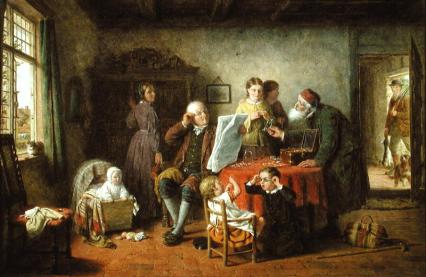
F. D. Hardy, Try This Pair, 1864 (Guildhall Art Gallery, London)
Kusama’s Infinity Rooms … Don’t Waste a Second
October 4, 2017
I’m thinking back to the afternoon in August when I took these photos at the Yayoi Kusama show at the Seattle Art Museum. What an experience.
Among Yayoi Kusama’s most famous works are her so-called “infinity rooms”—rooms with mirrors covering walls, ceilings, and sometimes floors so the reflections repeat to … well… infinity. The rooms are populated with forms—glowing pumpkins with black dots, white tuber-like forms with red dots, giant pink balls with black dots suspended from the ceiling. They multiply into a fantasticfield of color and shape and form. Standing in one of these rooms is really, really cool.
Here’s the thing.
At the exhibit, you can only stay in the room for 30 seconds before the guard knocks a warning and opens the door. For one room, it was only 20 seconds! Because you’ve been standing in line for many minutes and you’ve watched the shut-knock-open routine many times, by the time it’s your turn, you are very much aware of how fast your own 30 seconds is going to go. Let me tell you, it’s over way too soon.
Now, the whole exhibit feels like a spectacle, with gobs of people standing in lines that snake and coil through the galleries, so the very short time limit seems like just another part of the spectacle. This way, the exhibit accommodates more people, the museum claims more visitors, and Kusama has more viewers, more fame. Meanwhile the longer looks that lead to deeper analysis and contemplation are impossible.
This could have been deeply frustrating, but I was with my young kids so I rolled with it. We bounded from line to line like we were at an amusement park, thrilled by our 30-second rides on the aesthetic roller coasters. So much for long looks. Woo-wee! I loved it.
It was only later that I thought about what Kusama is up to with her time limits. She’s condensing the interaction with each artwork into a tight, intense experience of color, form, light, presence, space, infinity. She focuses your attention. She invites you to be present.
It goes like this. You wait and wait and wait. Anticipation grows. You turn a corner. You get tantalizing glimpses when the door opens and closes for others. Three steps closer. It’s almost your turn. You get briefed by the docent—no bags, no touching—okay.
NOW. You walk in and it’s your turn. You try to take in as much as you can, very much aware that the seconds are ticking. Look! Look close. Look out. Look up. Look around. Don’t waste a second.
Right.
Look close. Look out. Look around.
Don’t waste a second.
Cézanne … The Thing That Persists
July 27, 2017
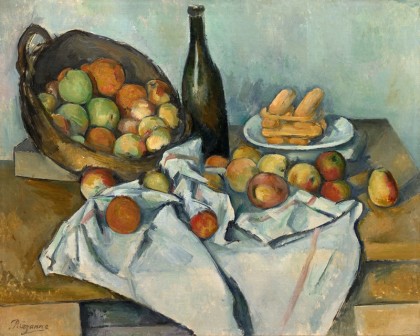
Paul Cezanne, The Basket of Apples, c. 1893
(Art Institute of Chicago)
Let’s talk about Cezanne.
I spent a few weeks in Chicago earlier this summer and had a chance to take some long looks at paintings by Cézanne at the Art Institute of Chicago. Visually, these paintings are forceful and deeply satisfying, but what I find to be especially compelling are the ideas they embody.
First, a contrast.
Cézanne followed the Impressionists and absorbed some of their ideas, but ultimately went in a different direction, choosing to pursue substance over surface. The Impressionists wanted to capture the fleeting moment—what something looks like right now rather than an hour ago or a month from now. They focused on the way the light plays off the surfaces, because it’s the surface that changes as the light shifts according to the time of day, the weather, the season.
Cézanne was more interested in that which persisted even while the light changed—the thingy-ness of the thing. Here, it’s the round firmness of the apple, the smooth solidity of the bottle, the dry crispness of the biscuits. The cloth, for example, is not simple a backdrop for the fruit; Cézanne makes it substantive. It has a real presence as it bunches up around the fruit. These things are real, solid objects in a physical space, not just a collection of surfaces for the transitory effects of color and light.
This choice gets at a philosophical difference regarding metaphysics, or what is really real.
What is more real: the way we perceive things from our specific and subjective point of view or the way those things actually are apart from our perception of them? Cézanne seems to assert that truth is found in the thing that persists, not in shifting perceptions. I appreciate the Impressionists’ awareness that modern life is inherently superficial and ephemeral. They capture not only images that are fleeting, but also the “reality” of subjective experience, all in the guise of pretty pictures.
But Cézanne rejects their interest in surfaces, which are ultimately empty, even meaningless. Instead, he tries to convey the substance that exists behind the surfaces. That substance is what is real because it is the thing that persists—it is both consistent and universal. That’s what is true.
This extends beyond how he paints individual objects to how he approaches the overall composition—the structure of the painting itself. The strong diagonal, firmly planted on a broad horizontal base and balanced with the vertical and horizontal elements of the bottle and biscuits. It is both stable and dynamic, precisely because he draws upon the time-honored fundamental principles of composition.
When I look at an Impressionist still-life, I see shimmery, effervescent forms that could dissolve in a moment. But in Cézanne’s I feel as if I can reach into that painting, grab a hold of that fruit, and sink my teeth into it. It’s satisfying.
Perhaps it’s satisfying precisely because I am keenly aware of how subjective experience determines our understanding of truth. We can’t escape our point of view entirely, so knowing objective truth seems virtually impossible.
But at the same time, I long for truth to be objectively known. I want to know. I want others to know.
So Cézanne offers a compelling vision. Forget all the subjective surfaces, and trust that truth—real objective truth—is real, persistent, steady, and compelling. It’s as real as that taut round pear or that starched linen tablecloth. Hold on to that.
And take that, Impressionists. Ha.
Divine Looking … and Instagram?
July 18, 2017
I haven’t posted anything here in quite a while. It’s not because I stopped my practice of spectatio divina. I’ve kept looking—closely looking—all the while. But there has been less space in my life these days and writing blog posts took the cut. Some regret with that.
I started another thing, though. Instagram!

Here’s the thing… until very recently, I didn’t see that what I have been doing with Instagram was another form of spectatio divina—it’s close looking, quite literally. I get close. Here, you can check it out: https://www.instagram.com/mshimizu10/?hl=en
When I started taking close-up photos of artworks and buildings, I did it because I wanted my friends to see these amazing brushstrokes or to experience this building as if they were standing right beside it. But as time went on, the photos became something I did for myself as much as for anybody else. As I contemplated which detail to focus on, or even which painting in a gallery, my own experience with the artwork became deeper. I noticed things I wouldn’t have otherwise. I was pulled into the artwork, pulled closer to the buildings. Close looking.
Here’s the question: Is looking closely the same as divine looking? Or… When I contemplate a brushstroke or a line, am I drawing closer to God? Am I listening to God? Do I hear his voice?
Obviously, the answers to these questions are not straight-forward. Because I never made the connection between taking close-up photos and my practice of spectatio divina, it seems clear that I was not actively listening to God. God never even crossed my mind as I tried to get my phone as close to a painting as the guards would allow.
In recent days, however, I’m beginning to rethink this.
First of all, I wonder how acknowledging God’s presence and voice prepares one for practicing spectatio divina. My initial thought would be that it is absolutely necessary. That’s part of the prayer. That’s what makes it different from “just thinking” about something. So I believe that centering is a crucial part of the disciplines, but now I wonder if I’m putting limits on the ability for God to speak to me. Couldn’t he have guided my eyes and thoughts even if I didn’t acknowledge him at that moment?
Second, I have been profoundly affected by some of these photos—sometimes by looking at the specific aspect of the artwork that the photo captured, sometimes by the very process of taking the photo. Something shifts, or clicks, or pokes. It hasn’t happened often, but it has happened.
Here’s my idea. What if I try to bridge the gap a bit? I could pull some of the Instagram shots into the blog to invite a more intentional, more prayerful looking. And, I could start inviting God into my close looking through the lens of my phone.
It’s a bit of an experiment. We’ll see…
Mother of God, But Still a Mama
February 9, 2016

Annibale Carracci,
The Holy Family with the Infant Saint John the Baptist, about 1600
(National Gallery, London)
I’m just back from London, where I spent many delightful hours at the National Gallery. This little painting caught my eye, which is little wonder because Carracci does that.
The motif is the Holy Family—the mother Mary, the baby Jesus, and Saint Joseph. It’s a traditional theme in Christian art, typically used to promote modeling one’s own family after this mostly divine one. Here, though, John the Baptist is included as well. That’s not unusual and he does fit the theme (we was a cousin of Mary and Jesus), but it does shift the meaning of the motif, especially in this painting.
The first thing I notice is how the figures of Mary and Jesus are so tightly tied together. They are turned toward each other and their heads are gently touching. Mary’s arm and Jesus’ arm and leg make a strong rectilinear shape emphasizing their unity, and their garments, particularly Mary’s robe, enclose them. We instantly understand that these two are lovingly bonded.
Both, however, glance to the outside. Jesus looks over his shoulder toward his earthly father, Joseph. What is happening between them is hard to identify—the way Joseph leans in is not playful or even loving exactly, but it’s not threatening either. He looks curious, like he is puzzling over this baby, maybe because of something he just read in that book. Jesus, for his part, looks a little wary.
Mary’s glance is much easier to identify. It seems like the infant John has tugged on her robe, causing her to look back. She is very much aware of what John represents, which is the knowledge that her baby—this Jesus—will be the Messiah. Carracci underscores this by putting the characteristic cruciform staff in John’s hand. Instinctively, Mary turns away from John, shielding Jesus from that message, that cross. Who can blame her?
This pair seems pushed from both sides. The sweet bond between mother and son seems disrupted by indications of what is to come. Both the traditional Jewish scriptures and the soon-to-be prophet John foreshadow how this is all going to end.
Yes, we should all be thrilled that the Messiah is come, but at the moment he’s just a baby. Can’t all the prophecy just wait a little?
But, no. Here’s Ash Wednesday.
Merry Christmas from Keith Haring
December 25, 2015

Keith Haring, Merry Christmas, 1985
It’s the day before Christmas. And while I clean and wrap and wipe runny noses (including my own), I’m trying to keep my mind on what I’m really preparing for. Advent. The Coming.
I’m thankful for Keith Haring’s subway drawing, which bypasses the usual schmaltzy iconography to get to the essence of what we’re celebrating. Here is the Son of God come down–miraculously–in the form of baby. It even looks like God is having contractions!
Enough said.
Merry Christmas out there….
The Shifting Image of God
December 7, 2015
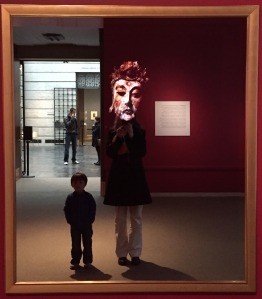
Lee Yongbaek,
In Between Buddha and Jesus, 2002
(Asian Art Museum, Seattle)
In a whirlwind visit to Seattle several weeks ago now, I was able to visit the Contemporary Korean Art exhibit at the Asian Art Museum. This particular work by Lee Yongbaek not only sucked me in at first look, but it drew me back into the exhibit for a second. My son too, as you can see.
As you stand and look at the mirror, you see images of sculpted heads flicker and morph in the middle of a dark, seemingly three-dimensional space. The heads are easily recognizable as Buddha and Jesus, sculpted by other artists in other times, although they sometimes shift from one to the next so quickly that you can’t see them distinctly.
The work is not hard to understand, at least on a basic level. Here, east meets west. Lee points to the tension between two gods that sometimes exist at the extremes of cultural difference, but by conflating the two, he puts them into a symbiotic relationship, like conjoined twins or some sci-fi double being. In this way, he explores the cultural divide by bringing them intimately close.
But that’s not what grabbed me. Even as the heads change rapidly from one to the next, there are moments when a head lingers for a few seconds—as if suspended or caught—and then it twitches before finally morphing into the next. It feels like it is trying to hold on, but it just can’t.
In those moments, it seems as if there is some sort of glitch in the system—something is not working—like the smooth flow between the two divine beings has been interrupted, disrupted, obstructed. It reminds me of the holodeck on Star Trek when something in the hologram “twitches” and Captain Picard knows that something is not right. 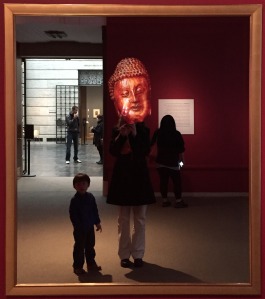
Lee seems to be giving away the ruse. Sure, he’s merging these two gods together in order to suggest that perhaps they are not so different after all. But he seems to admit that this vision is just that—a vision. It’s not real. It can never be real. It will only ever be an illusion … like a hologram.
To push this a little further, it’s not just the vision of a harmonious religion that is tenuous here. The images of each god are fundamentally unstable. Even when the image lingers for a few moments, it eventually gets pulled into the next.
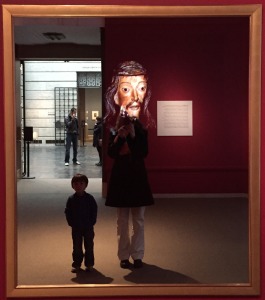 In other words, the images repeatedly lose their integrity—as images of the divine ought to do. An image of a god is not the god they represent. An image is always limited, always contrived. And yet we hang on to those images. Sometimes desperately or even zealously.
In other words, the images repeatedly lose their integrity—as images of the divine ought to do. An image of a god is not the god they represent. An image is always limited, always contrived. And yet we hang on to those images. Sometimes desperately or even zealously.
This time of year—Advent—I am so aware of the use of images to encapsulate the birth narrative of Jesus. Some images can be powerful, others painfully trite. Either way, it’s all too tempting to let the images be the story. It’s hard enough already to keep from reducing Christmas down to a few lovely sentiments, pictures of Mary, Joseph, and a cute little baby don’t help.
Perhaps this season, I will try to look at images in order to see through them. I don’t mean this in a cynical sense (although my propensity for such things could lead me there…bah, nostalgia, consumerism, and sublimation!). Instead I could look for ways that images point toward the depth and richness of the narrative and the theology of the incarnation, maybe even in spite of themselves.
I’ll keep you posted.
Trusting Strangers … A Lesson from Photographs
October 14, 2015
I’m looking backward again. While in Chicago last summer I visited Richard Renaldi’s “Touching Strangers” exhibition at the Loyola University Museum of Art. This series has gotten a lot of attention and I’m still mulling it over.

Renaldi
On the surface, the idea is an easy one: Renaldi asks people who have never met to pose in an intimate way—as if they are a couple, family, or close friends—and then he takes a photograph.
Okay … but there are a lot of (mostly unanswered) questions here. How did he approach them? When the participants are in a private space—like a hotel room—how did he get them there? How did he pick them? What did he say when he first approached them? Did they decide how to touch or was there some coaching? If so, how much?

Renaldi
After a little digging, I did find a answers to the last couple questions. Apparently, Renaldi did make suggestions to the participants—like to flirt or even kiss. This makes sense if you’re a photographer wanting interesting photographs. It makes less sense if you want to really explore the connection between touch and relationship, which was the series’ ostensible reason d’etre.
In fact, after looking at the first half-dozen photographs in the gallery that day in June, I found the basic interpretation of the project to be all wrong. I had read that Renaldi is using touch to make spontaneous and fleeting relationships between strangers. I don’t think so. He’s just asking them to touch, and touching does not necessarily mean a relationship has formed, even a fleeting one.
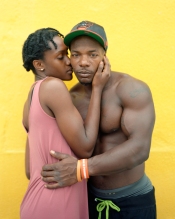
Renaldi
This demands a little interrogation. For some photos, you could say that the subjects performed relationship because they got into it and acted like they were in a relationship. Or, you could say that the relationship he created was “two people who participated in this artist’s project.” And maybe for a few of the photographs, the brief interaction did lead to a real connection between of the participants. But as a whole, these photographs are not about relationships in any meaningful sense of the term.
Now, despite this criticism, I think this project is fascinating—just not for the reason Renaldi and others have proposed.
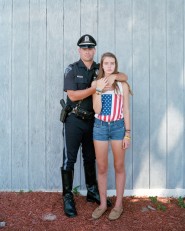
Renaldi
As I walked around the gallery, I was struck again and again by how the subjects dealt with the issue of trust. To participate, they had to trust each other and they had to trust Renaldi—and all the more so because they were directed to pose in intimate ways. To shake a hand is one thing, to kiss or even hug is quite another.

Renaldi
For me, each photograph became a study about how different people react when this kind of trust is requested or even demanded of them. For some, they throw themselves at it, as if the best way to trust is to pretend there’s nothing at risk. For others, they tense up and exert their will over any fears. Others seem to be comfortable with the scenario—as if they have a natural trust in people, even strangers.
Maybe this has struck home because I have young children and the idea of “stranger danger” is everywhere. My mama bear instincts flash when someone I don’t know even talks to my children, let alone touches them. And yet, I don’t want my children to grow up always keeping strangers at arm’s-length. I want them to reach out. I want them to practice hospitality.
There are so many passages in the Bible that stress the importance of hospitality—welcoming strangers, into one’s home, trusting them in order to give them a place for refuge or rest. One of my favorites comes from Hebrews: “Do not neglect to show hospitality to strangers, for by this some have entertained angels without knowing it” (13:2).
With the refugee crisis growing around the world right now, we can see the relationship between trust and hospitality playing out. There are millions of strangers who desperately need a place of rest and refuge. Do we have the trust to reach out and welcome them? Where is our trust?
Of course, our trust is in God. God calls us to open our doors, to kindle a fire, to prepare a meal… to touch a stranger as if she is family, as if he is an intimate friend.
And when we reach out, we place our trust in God.
I just wish it were that easy.
Casting Stones
September 30, 2015
After a long hiatus for a whole mess of reasons, I’m returning to the discipline of looking and praying and writing. I never stopped looking, but it’s time to get back to the praying and writing. I need it.
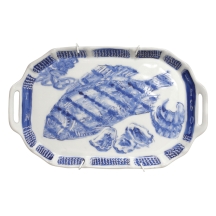 Julie Green’s Last Supper has been on my mind since I saw it at the Block Museum of Art at Northwestern University this summer. The project, I think, is brilliant. In a nutshell, she has painted about 500 (and counting) individual plates to show the meal requests of death row inmates. She includes the state where the execution occurred and the date. Sometimes, when there was no last meal, she has text simply describing situation–a denied request or no request at all, for example.
Julie Green’s Last Supper has been on my mind since I saw it at the Block Museum of Art at Northwestern University this summer. The project, I think, is brilliant. In a nutshell, she has painted about 500 (and counting) individual plates to show the meal requests of death row inmates. She includes the state where the execution occurred and the date. Sometimes, when there was no last meal, she has text simply describing situation–a denied request or no request at all, for example.
To stand in a room full of these plates—there were 357 in the exhibition I saw—is haunting. I felt the presence of these individuals. I knew approximately three things about them, but that was enough to make each one a distinct individual. There is something oddly intimate about knowing what someone wanted for their very last meal.
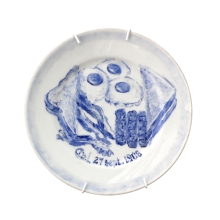 Bagels and coffee. Three eggs, three slices of bacon, three sausages and toast. Fried chicken and watermelon. Grilled fish, oysters, and prawns. Four eggs, four chicken drumsticks, salsa, four jalapeno peppers, lettuce, tortillas, hash browns, garlic bread, two pork chops, white and yellow grated cheese, sliced onions and tomatoes, a pitcher of milk and a vanilla milkshake. A pack of cigarettes.
Bagels and coffee. Three eggs, three slices of bacon, three sausages and toast. Fried chicken and watermelon. Grilled fish, oysters, and prawns. Four eggs, four chicken drumsticks, salsa, four jalapeno peppers, lettuce, tortillas, hash browns, garlic bread, two pork chops, white and yellow grated cheese, sliced onions and tomatoes, a pitcher of milk and a vanilla milkshake. A pack of cigarettes.
Green helps us to think about the humanity of these individuals. By showing us something about them that is so basically human, she deters our tendency to view these individuals as “the evil other,” and instead gives us something in common with them. What would you request?
 Green’s choices underscore her message. Because she uses second-hand plates—and each one unique—the plates feel so personal. As objects, they had previous lives in which they held other meals for other people, and now they carry their own last meals as well. At the same time, there is something monumental and unified about the plates because there are so many of them, and all painted in a brushy style with cobalt blue. There is, after all, one thing that unites all the different lives these plates represent.
Green’s choices underscore her message. Because she uses second-hand plates—and each one unique—the plates feel so personal. As objects, they had previous lives in which they held other meals for other people, and now they carry their own last meals as well. At the same time, there is something monumental and unified about the plates because there are so many of them, and all painted in a brushy style with cobalt blue. There is, after all, one thing that unites all the different lives these plates represent.
What makes this particularly brilliant, at least to my mind, is how Green subtly draws a connection between these individuals and Jesus. The title “Last Supper” is not simply a play on a well-established subject matter in art, she uses it to make bigger claims (or ask bigger questions).
After all—Christ, too, was executed. He also had a last meal.
In this, her project takes on a slightly different angle. Can justice ever be fair, true, and impartial? In Jesus’ case, clearly not. Jesus was tried on trumped-up charges and condemned by a judge who was clearly manipulated by a powerful interest group. And our own justice system? How many of these death sentences have been the result of similar circumstances? How can we ever know?
A student who was with me in the exhibition pointed out that Green’s approach completely elides the facts about the crimes these prisoners committed and that, if we knew the charges, our feelings of connection and maybe even sympathy would likely be significantly diminished. I agree.
What Green does, however, is level the field—to emphasize our common humanity—in order to question our right to judge and condemn to death. Even if they have committed heinous crimes and “deserve to die,” do we have the right to kill them? Jesus said it: “You who are without sin cast the first stone.”
The would-be executioners that Jesus confronted that day knew they needed to put down their stones. Do we?



